Yinfeng Yu
DGFNet: End-to-End Audio-Visual Source Separation Based on Dynamic Gating Fusion
Apr 30, 2025Abstract:Current Audio-Visual Source Separation methods primarily adopt two design strategies. The first strategy involves fusing audio and visual features at the bottleneck layer of the encoder, followed by processing the fused features through the decoder. However, when there is a significant disparity between the two modalities, this approach may lead to the loss of critical information. The second strategy avoids direct fusion and instead relies on the decoder to handle the interaction between audio and visual features. Nonetheless, if the encoder fails to integrate information across modalities adequately, the decoder may be unable to effectively capture the complex relationships between them. To address these issues, this paper proposes a dynamic fusion method based on a gating mechanism that dynamically adjusts the modality fusion degree. This approach mitigates the limitations of solely relying on the decoder and facilitates efficient collaboration between audio and visual features. Additionally, an audio attention module is introduced to enhance the expressive capacity of audio features, thereby further improving model performance. Experimental results demonstrate that our method achieves significant performance improvements on two benchmark datasets, validating its effectiveness and advantages in Audio-Visual Source Separation tasks.
DOPE: Dual Object Perception-Enhancement Network for Vision-and-Language Navigation
Apr 30, 2025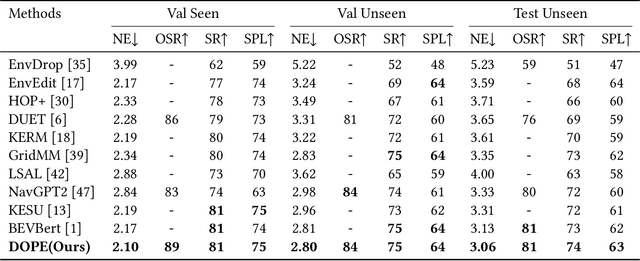
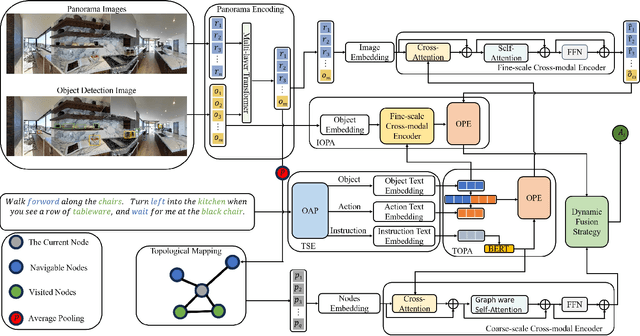
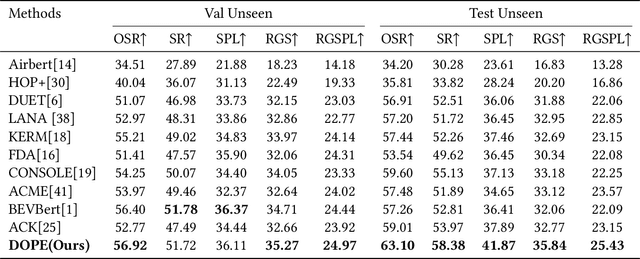
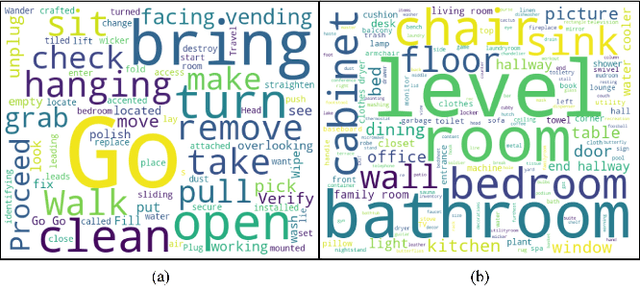
Abstract:Vision-and-Language Navigation (VLN) is a challenging task where an agent must understand language instructions and navigate unfamiliar environments using visual cues. The agent must accurately locate the target based on visual information from the environment and complete tasks through interaction with the surroundings. Despite significant advancements in this field, two major limitations persist: (1) Many existing methods input complete language instructions directly into multi-layer Transformer networks without fully exploiting the detailed information within the instructions, thereby limiting the agent's language understanding capabilities during task execution; (2) Current approaches often overlook the modeling of object relationships across different modalities, failing to effectively utilize latent clues between objects, which affects the accuracy and robustness of navigation decisions. We propose a Dual Object Perception-Enhancement Network (DOPE) to address these issues to improve navigation performance. First, we design a Text Semantic Extraction (TSE) to extract relatively essential phrases from the text and input them into the Text Object Perception-Augmentation (TOPA) to fully leverage details such as objects and actions within the instructions. Second, we introduce an Image Object Perception-Augmentation (IOPA), which performs additional modeling of object information across different modalities, enabling the model to more effectively utilize latent clues between objects in images and text, enhancing decision-making accuracy. Extensive experiments on the R2R and REVERIE datasets validate the efficacy of the proposed approach.
AMNet: An Acoustic Model Network for Enhanced Mandarin Speech Synthesis
Apr 12, 2025Abstract:This paper presents AMNet, an Acoustic Model Network designed to improve the performance of Mandarin speech synthesis by incorporating phrase structure annotation and local convolution modules. AMNet builds upon the FastSpeech 2 architecture while addressing the challenge of local context modeling, which is crucial for capturing intricate speech features such as pauses, stress, and intonation. By embedding a phrase structure parser into the model and introducing a local convolution module, AMNet enhances the model's sensitivity to local information. Additionally, AMNet decouples tonal characteristics from phonemes, providing explicit guidance for tone modeling, which improves tone accuracy and pronunciation. Experimental results demonstrate that AMNet outperforms baseline models in subjective and objective evaluations. The proposed model achieves superior Mean Opinion Scores (MOS), lower Mel Cepstral Distortion (MCD), and improved fundamental frequency fitting $F0 (R^2)$, confirming its ability to generate high-quality, natural, and expressive Mandarin speech.
Leveraging Label Potential for Enhanced Multimodal Emotion Recognition
Apr 07, 2025Abstract:Multimodal emotion recognition (MER) seeks to integrate various modalities to predict emotional states accurately. However, most current research focuses solely on the fusion of audio and text features, overlooking the valuable information in emotion labels. This oversight could potentially hinder the performance of existing methods, as emotion labels harbor rich, insightful information that could significantly aid MER. We introduce a novel model called Label Signal-Guided Multimodal Emotion Recognition (LSGMER) to overcome this limitation. This model aims to fully harness the power of emotion label information to boost the classification accuracy and stability of MER. Specifically, LSGMER employs a Label Signal Enhancement module that optimizes the representation of modality features by interacting with audio and text features through label embeddings, enabling it to capture the nuances of emotions precisely. Furthermore, we propose a Joint Objective Optimization(JOO) approach to enhance classification accuracy by introducing the Attribution-Prediction Consistency Constraint (APC), which strengthens the alignment between fused features and emotion categories. Extensive experiments conducted on the IEMOCAP and MELD datasets have demonstrated the effectiveness of our proposed LSGMER model.
Magnitude-Phase Dual-Path Speech Enhancement Network based on Self-Supervised Embedding and Perceptual Contrast Stretch Boosting
Mar 27, 2025Abstract:Speech self-supervised learning (SSL) has made great progress in various speech processing tasks, but there is still room for improvement in speech enhancement (SE). This paper presents BSP-MPNet, a dual-path framework that combines self-supervised features with magnitude-phase information for SE. The approach starts by applying the perceptual contrast stretching (PCS) algorithm to enhance the magnitude-phase spectrum. A magnitude-phase 2D coarse (MP-2DC) encoder then extracts coarse features from the enhanced spectrum. Next, a feature-separating self-supervised learning (FS-SSL) model generates self-supervised embeddings for the magnitude and phase components separately. These embeddings are fused to create cross-domain feature representations. Finally, two parallel RNN-enhanced multi-attention (REMA) mask decoders refine the features, apply them to the mask, and reconstruct the speech signal. We evaluate BSP-MPNet on the VoiceBank+DEMAND and WHAMR! datasets. Experimental results show that BSP-MPNet outperforms existing methods under various noise conditions, providing new directions for self-supervised speech enhancement research. The implementation of the BSP-MPNet code is available online\footnote[2]{https://github.com/AlimMat/BSP-MPNet. \label{s1}}
Modality-Invariant Bidirectional Temporal Representation Distillation Network for Missing Multimodal Sentiment Analysis
Jan 07, 2025
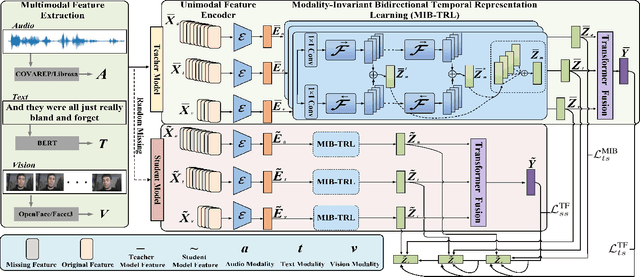
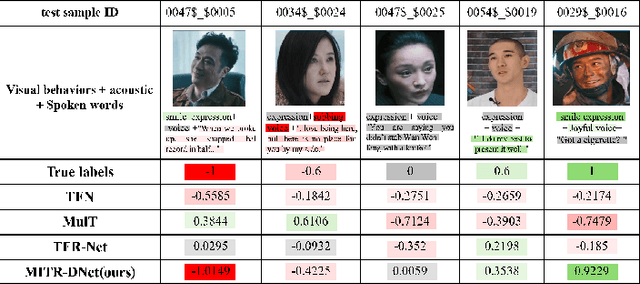
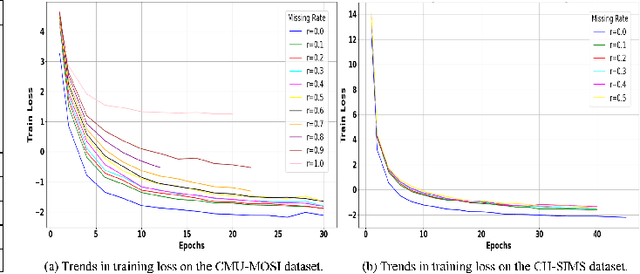
Abstract:Multimodal Sentiment Analysis (MSA) integrates diverse modalities(text, audio, and video) to comprehensively analyze and understand individuals' emotional states. However, the real-world prevalence of incomplete data poses significant challenges to MSA, mainly due to the randomness of modality missing. Moreover, the heterogeneity issue in multimodal data has yet to be effectively addressed. To tackle these challenges, we introduce the Modality-Invariant Bidirectional Temporal Representation Distillation Network (MITR-DNet) for Missing Multimodal Sentiment Analysis. MITR-DNet employs a distillation approach, wherein a complete modality teacher model guides a missing modality student model, ensuring robustness in the presence of modality missing. Simultaneously, we developed the Modality-Invariant Bidirectional Temporal Representation Learning Module (MIB-TRL) to mitigate heterogeneity.
Heterogeneous Space Fusion and Dual-Dimension Attention: A New Paradigm for Speech Enhancement
Aug 13, 2024Abstract:Self-supervised learning has demonstrated impressive performance in speech tasks, yet there remains ample opportunity for advancement in the realm of speech enhancement research. In addressing speech tasks, confining the attention mechanism solely to the temporal dimension poses limitations in effectively focusing on critical speech features. Considering the aforementioned issues, our study introduces a novel speech enhancement framework, HFSDA, which skillfully integrates heterogeneous spatial features and incorporates a dual-dimension attention mechanism to significantly enhance speech clarity and quality in noisy environments. By leveraging self-supervised learning embeddings in tandem with Short-Time Fourier Transform (STFT) spectrogram features, our model excels at capturing both high-level semantic information and detailed spectral data, enabling a more thorough analysis and refinement of speech signals. Furthermore, we employ the innovative Omni-dimensional Dynamic Convolution (ODConv) technology within the spectrogram input branch, enabling enhanced extraction and integration of crucial information across multiple dimensions. Additionally, we refine the Conformer model by enhancing its feature extraction capabilities not only in the temporal dimension but also across the spectral domain. Extensive experiments on the VCTK-DEMAND dataset show that HFSDA is comparable to existing state-of-the-art models, confirming the validity of our approach.
VNet: A GAN-based Multi-Tier Discriminator Network for Speech Synthesis Vocoders
Aug 13, 2024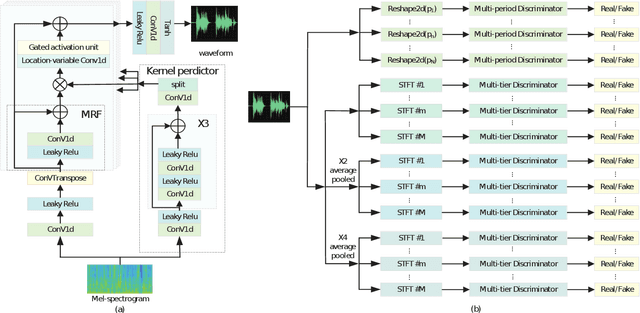
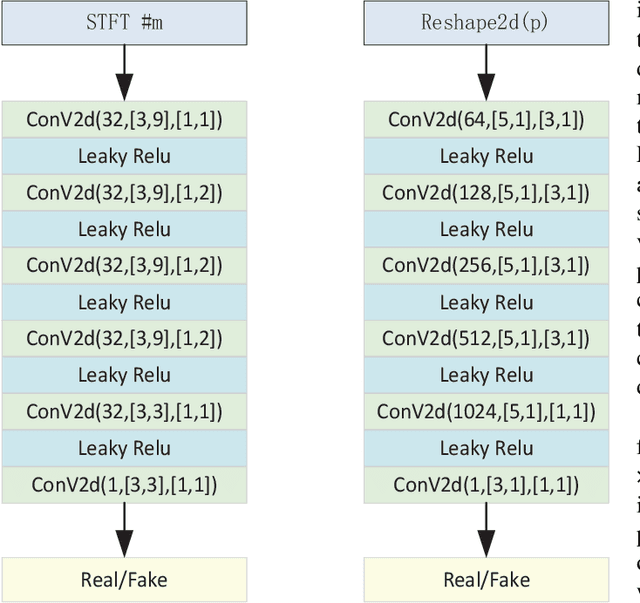


Abstract:Since the introduction of Generative Adversarial Networks (GANs) in speech synthesis, remarkable achievements have been attained. In a thorough exploration of vocoders, it has been discovered that audio waveforms can be generated at speeds exceeding real-time while maintaining high fidelity, achieved through the utilization of GAN-based models. Typically, the inputs to the vocoder consist of band-limited spectral information, which inevitably sacrifices high-frequency details. To address this, we adopt the full-band Mel spectrogram information as input, aiming to provide the vocoder with the most comprehensive information possible. However, previous studies have revealed that the use of full-band spectral information as input can result in the issue of over-smoothing, compromising the naturalness of the synthesized speech. To tackle this challenge, we propose VNet, a GAN-based neural vocoder network that incorporates full-band spectral information and introduces a Multi-Tier Discriminator (MTD) comprising multiple sub-discriminators to generate high-resolution signals. Additionally, we introduce an asymptotically constrained method that modifies the adversarial loss of the generator and discriminator, enhancing the stability of the training process. Through rigorous experiments, we demonstrate that the VNet model is capable of generating high-fidelity speech and significantly improving the performance of the vocoder.
BSS-CFFMA: Cross-Domain Feature Fusion and Multi-Attention Speech Enhancement Network based on Self-Supervised Embedding
Aug 13, 2024Abstract:Speech self-supervised learning (SSL) represents has achieved state-of-the-art (SOTA) performance in multiple downstream tasks. However, its application in speech enhancement (SE) tasks remains immature, offering opportunities for improvement. In this study, we introduce a novel cross-domain feature fusion and multi-attention speech enhancement network, termed BSS-CFFMA, which leverages self-supervised embeddings. BSS-CFFMA comprises a multi-scale cross-domain feature fusion (MSCFF) block and a residual hybrid multi-attention (RHMA) block. The MSCFF block effectively integrates cross-domain features, facilitating the extraction of rich acoustic information. The RHMA block, serving as the primary enhancement module, utilizes three distinct attention modules to capture diverse attention representations and estimate high-quality speech signals. We evaluate the performance of the BSS-CFFMA model through comparative and ablation studies on the VoiceBank-DEMAND dataset, achieving SOTA results. Furthermore, we select three types of data from the WHAMR! dataset, a collection specifically designed for speech enhancement tasks, to assess the capabilities of BSS-CFFMA in tasks such as denoising only, dereverberation only, and simultaneous denoising and dereverberation. This study marks the first attempt to explore the effectiveness of self-supervised embedding-based speech enhancement methods in complex tasks encompassing dereverberation and simultaneous denoising and dereverberation. The demo implementation of BSS-CFFMA is available online\footnote[2]{https://github.com/AlimMat/BSS-CFFMA. \label{s1}}.
PCQ: Emotion Recognition in Speech via Progressive Channel Querying
Jul 17, 2024Abstract:In human-computer interaction (HCI), Speech Emotion Recognition (SER) is a key technology for understanding human intentions and emotions. Traditional SER methods struggle to effectively capture the long-term temporal correla-tions and dynamic variations in complex emotional expressions. To overcome these limitations, we introduce the PCQ method, a pioneering approach for SER via \textbf{P}rogressive \textbf{C}hannel \textbf{Q}uerying. This method can drill down layer by layer in the channel dimension through the channel query technique to achieve dynamic modeling of long-term contextual information of emotions. This mul-ti-level analysis gives the PCQ method an edge in capturing the nuances of hu-man emotions. Experimental results show that our model improves the weighted average (WA) accuracy by 3.98\% and 3.45\% and the unweighted av-erage (UA) accuracy by 5.67\% and 5.83\% on the IEMOCAP and EMODB emotion recognition datasets, respectively, significantly exceeding the baseline levels.
 Add to Chrome
Add to Chrome Add to Firefox
Add to Firefox Add to Edge
Add to Edge